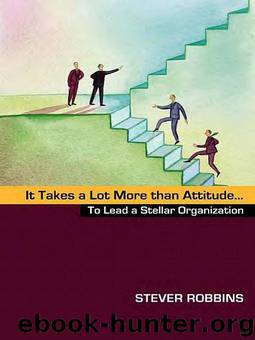It Takes a Lot More than Attitude...to Lead a Stellar Organization by Stever Robbins

Author:Stever Robbins
Language: eng
Format: mobi
Publisher: Electronic & Database Publishing, Inc.
Published: 2008-06-30T14:00:00+00:00
tion create the leadership relationship.”
Lastly, followers need to feel connectedto their leaders. Leaders almost always connect through shared values; that’s one reason followers leave when a leader doesn’t live his or her values. Helping people feel they are part of something much greater—giving them a personal vision—is another strong tactic. For instance, a leader in the healthcare industry may say, “You’re not just joining our company, you’re becoming part of transforming the world of healthcare.” Recognizing and rewarding employee achievement helps cement the connection. On the other hand, taking credit for others’ work is a powerful connection destroyer.
I was surprised by this framework’s simplicity—direction, integrity, consistency, and connection. But its simplicity hides how difficult it is to pull off. It’s difficult because these qualities can’t be faked for long. Creating a direction is easy. Integrating it into every breath and decision is not. Choosing values is easy. Aligning behavior, decision-making, policies, and organization around those values is not. Consistency is easy … until things don’t go quite as planned. And connection is easy until things get busy and instinct tells us to stop all this fluffy foolishness and just get down to work.
Building the organization
Direction, integrity, consistency, and connection create the leadership relationship. That’s a first step in building an organization, but it doesn’t address the issue of how leaders make their organizations successful. History is littered with great leaders who didn’t have a clue how to turn their leadership into an enduring business. Let me share some of the highlights:
• Focus, focus, focus. Know what the organization should be doing and ruthlessly say “no” to anything that would be a distraction.
• Play to individual strengths. Understand the abilities of everyone you hire and make sure their job plays to their strengths. Don’t spend too much time developing weak areas. If someone can go from goodto-great in their strength, that’s more valuable to the organization than taking someone from poor-to-acceptable. Build organizational com- petence by teaming up complementary skill sets. Ditto for yourself; know what you’re good at and can do well, and spend most of your time doing that.
• Play to organizational strengths. Stick to what you’re good at as a company, and get very good at it. If you’re a great software company, opening a chain of high-end fashion clothing stores won’t build a strong organization.
• You can train people for skills, but it’s much harder to train attitude. Most companies hire for specific job history or resume keywords, which is precisely the wrong way to go about it. Hire for attitude first.
• Bring out the best in your people. Hire the best, give them a common direction, and let them do their job. You’ll have a much stronger organization than if you make yourself too important. Remember: Every time you hire someone who isn’t as smart as you, you lower the average IQ of the company.
You’ll notice that I’ve defined leadership as mostly “soft” skills. It is. When it comes to leadership, I remember what the Vice-Chairman
Download
This site does not store any files on its server. We only index and link to content provided by other sites. Please contact the content providers to delete copyright contents if any and email us, we'll remove relevant links or contents immediately.
Hit Refresh by Satya Nadella(8855)
The Compound Effect by Darren Hardy(8513)
Change Your Questions, Change Your Life by Marilee Adams(7377)
Nudge - Improving Decisions about Health, Wealth, and Happiness by Thaler Sunstein(7244)
The Black Swan by Nassim Nicholas Taleb(6770)
Deep Work by Cal Newport(6563)
Daring Greatly by Brene Brown(6227)
Rich Dad Poor Dad by Robert T. Kiyosaki(6179)
Principles: Life and Work by Ray Dalio(5961)
Man-made Catastrophes and Risk Information Concealment by Dmitry Chernov & Didier Sornette(5650)
Playing to Win_ How Strategy Really Works by A.G. Lafley & Roger L. Martin(5506)
Digital Minimalism by Cal Newport;(5392)
Big Magic: Creative Living Beyond Fear by Elizabeth Gilbert(5353)
The Myth of the Strong Leader by Archie Brown(5239)
The Slight Edge by Jeff Olson(5200)
Discipline Equals Freedom by Jocko Willink(5157)
The Motivation Myth by Jeff Haden(5004)
Stone's Rules by Roger Stone(4859)
The Laws of Human Nature by Robert Greene(4774)
